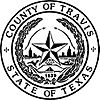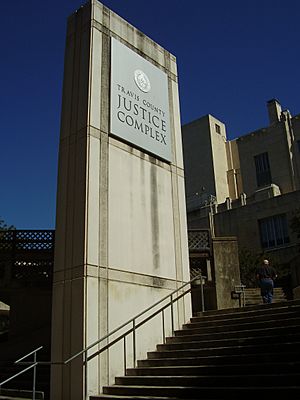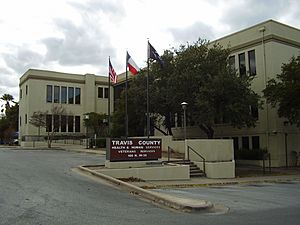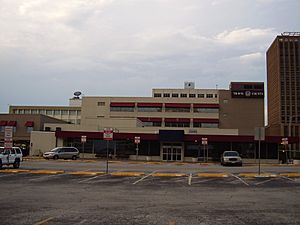Travis County, Texas facts for kids
Quick facts for kids
Travis County
|
||
|---|---|---|
|
County
|
||
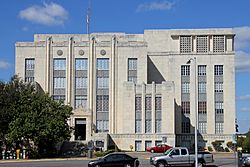
Heman Marion Sweatt Travis County Courthouse in Austin
|
||
|
||
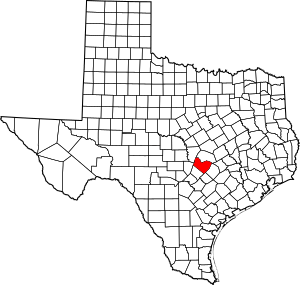
Location within the U.S. state of Texas
|
||
 Texas's location within the U.S. |
||
| Country | ||
| State | ||
| Founded | 1840 | |
| Named for | William B. Travis | |
| Seat | Austin | |
| Largest city | Austin | |
| Area | ||
| • Total | 1,023 sq mi (2,650 km2) | |
| • Land | 990 sq mi (2,600 km2) | |
| • Water | 33 sq mi (90 km2) 3.2% | |
| Population
(2020)
|
||
| • Total | 1,290,188 |
|
| Time zone | UTC−6 (Central) | |
| • Summer (DST) | UTC−5 (CDT) | |
| Congressional districts | 10th, 17th, 21st, 25th, 35th, 37th | |
Travis County is located in south central Texas. As of the 2020 census, the population was 1,290,188. It is the fifth-most populous county in Texas. Its county seat is Austin, the capital of Texas. The county was established in 1840 and is named in honor of William Barret Travis, the commander of the Republic of Texas forces at the Battle of the Alamo. Travis County is part of the Austin–Round Rock-Georgetown Metropolitan Statistical Area. It is located along the Balcones Fault, the boundary between the Edwards Plateau to the west and the Blackland Prairie to the east.
History
Pre-Columbian and colonial periods
Evidence of habitation of the Balcones Escarpment region of Texas can be traced to at least 11,000 years ago. Two of the oldest Paleolithic archeological sites in Texas, the Levi Rock Shelter and Smith Rock Shelter, are located in southwest and southeast Travis County, respectively. Several hundred years before the arrival of European settlers, the area was inhabited by a variety of nomadic Native American tribes. These indigenous peoples fished and hunted along the creeks, including present-day Barton Springs, which proved to be a reliable campsite. At the time of the first permanent settlement of the area, the Tonkawa tribe was the most common, with the Comanches and Lipan Apaches also frequenting the area.
The region (along with all of modern Texas) was claimed by the Spanish Empire in the 1600s, but at the time no attempt was made to settle the area (or even to fully explore it). In 1691 Domingo Terán de los Ríos made an inspection tour through East Texas that likely took him through Travis Country. The first European settlers in the area were a group of Spanish friars who arrived from East Texas in July 1730. They established three temporary missions, La Purísima Concepción, San Francisco de los Neches and San José de los Nazonis, on a site by the Colorado River near Barton Springs. The friars found conditions undesirable and relocated to the San Antonio River within a year of their arrival.
Mexican period
In 1821 Mexico won its independence from Spain, and the new government enacted laws encouraging colonists to settle the Texas frontier by granting them land and reduced taxation. Over the next decade, thousands of foreign immigrants (primarily from the United States) moved into Texas; in particular, American empresario Stephen F. Austin established one of his colonies near what is now Bastrop, Texas (in future Travis County) in 1827. Josiah and Mathias Wilbarger, Reuben Hornsby, Jacob M. Harrell, and John F. Webber were early settlers who moved into the area in the early 1830s.
Republican period
In 1836 Texas declared and won its independence from Mexico, forming a new Republic of Texas. After Texas Vice President Mirabeau B. Lamar visited central Texas during a buffalo-hunting expedition between 1837 and 1838, he proposed that the republic's capital (then located in Houston) be relocated to a site on the north bank of the Colorado River. In 1839 the site was officially chosen as the republic's new capital and given the name Waterloo, Texas; shortly thereafter the city's name was changed to Austin in honor of Stephen F. Austin. A new county was also established the following year, of which Austin would be the seat; the county was named Travis County, after William B. Travis. Though the Republic's capital moved briefly back to Houston during the events surrounding the Texas Archive War, by 1845 Austin was again the capital, and it became the capital of the new State of Texas when Texas was annexed by the United States later that year.
Civil War and beyond
In 1861 Travis County was one of the few Texas counties to vote against secession from the Union. Since the majority of the state did favor secession, Travis County then became a part of the Confederacy for the duration of the Civil War. After the Confederacy's defeat, Texas was fully readmitted to the Union in 1870.
From the end of the Civil War to the early twenty-first century, Travis County has experienced steady, rapid population growth (averaging more than a 36% increase every decade from 1870 to 2010), driven largely by the growth of Austin and its suburbs; it is now the fifth most populous county in Texas, after Harris (Houston), Dallas, Tarrant (Fort Worth) and Bexar (San Antonio) counties.
Geography
According to the U.S. Census Bureau, the county has a total area of 1,023 square miles (2,650 km2), of which 990 square miles (2,600 km2) is land and 33 square miles (85 km2) (3.2%) is water. Travis County is located in the southern part of central Texas, between San Antonio and Dallas–Fort Worth. The county's geographical center lies two miles northwest of downtown Austin at 30°18' north latitude and 97°45' west longitude.
Travis County straddles the Balcones Fault, the boundary between the Edwards Plateau to the west and the Texas Coastal Plain to the east. The western part of the county is characterized by the karst topography of the Texas Hill Country, while the eastern part exhibits the fertile plains and farmlands of the Blackland Prairie. The Colorado River meanders through the county from west to east, forming a series of man-made lakes (Lake Travis, Lake Austin, and Lady Bird Lake).
Springs
The limestone karst geology of the western and southwestern parts of Travis County gives rise to numerous caverns and springs, some of which have provided shelter and water for humans in the region for thousands of years. Notable springs in the county include Barton Springs, Deep Eddy and Hamilton Pool.
Major highways
Travis County is crossed by Interstate Highway 35, US Highways 183 and 290, and Texas Highway 71. IH-35 leads northward to Waco and Dallas–Fort Worth and southward to San Antonio. US-183 leads northward through Cedar Park to Lampasas and southward to Lockhart. US-290 leads westward to Fredericksburg and eastward to Houston. TX-71 leads westward to Marble Falls and eastward to Bastrop.
Other major highways within the county include Texas Highway Loop 1 (the "Mopac Expressway"), which runs from north to south through the center of the county, and Texas Highway 45, which forms parts of an incomplete highway loop around Austin. Texas Highway 130 (constructed as an alternative to IH-35 for long-distance traffic wishing to avoid Austin and San Antonio) also runs from north to south through the sparsely populated eastern part of the county.
Adjacent counties
- Williamson County (north)
- Bastrop County (east)
- Caldwell County (south)
- Hays County (southwest)
- Blanco County (west)
- Burnet County (northwest)
Protected areas
Demographics
| Historical population | |||
|---|---|---|---|
| Census | Pop. | %± | |
| 1850 | 3,138 | — | |
| 1860 | 8,080 | 157.5% | |
| 1870 | 13,153 | 62.8% | |
| 1880 | 27,028 | 105.5% | |
| 1890 | 36,322 | 34.4% | |
| 1900 | 47,386 | 30.5% | |
| 1910 | 55,620 | 17.4% | |
| 1920 | 57,616 | 3.6% | |
| 1930 | 77,777 | 35.0% | |
| 1940 | 111,053 | 42.8% | |
| 1950 | 160,980 | 45.0% | |
| 1960 | 212,136 | 31.8% | |
| 1970 | 295,516 | 39.3% | |
| 1980 | 419,573 | 42.0% | |
| 1990 | 576,407 | 37.4% | |
| 2000 | 812,280 | 40.9% | |
| 2010 | 1,024,266 | 26.1% | |
| 2020 | 1,290,188 | 26.0% | |
| U.S. Decennial Census 1850–2010 2010–2020 |
|||
2020 census
| Race / Ethnicity | Pop 2010 | Pop 2020 | % 2010 | % 2020 |
|---|---|---|---|---|
| White alone (NH) | 517,644 | 612,824 | 50.54% | 47.50% |
| Black or African American alone (NH) | 82,805 | 96,270 | 8.08% | 7.46% |
| Native American or Alaska Native alone (NH) | 2,611 | 2,762 | 0.25% | 0.21% |
| Asian alone (NH) | 58,404 | 99,660 | 5.70% | 7.72% |
| Pacific Islander alone (NH) | 540 | 774 | 0.05% | 0.06% |
| Some Other Race alone (NH) | 1,813 | 6,513 | 0.18% | 0.50% |
| Mixed Race/Multi-Racial (NH) | 17,683 | 50,275 | 1.73% | 3.90% |
| Hispanic or Latino (any race) | 342,766 | 421,110 | 33.46% | 32.64% |
| Total | 1,024,266 | 1,290,188 | 100.00% | 100.00% |
Note: the US Census treats Hispanic/Latino as an ethnic category. This table excludes Latinos from the racial categories and assigns them to a separate category. Hispanics/Latinos can be of any race.
2010 Census
According to the census of 2010, there were 1,024,266 people, 320,766 households, and 183,798 families residing in the county. The population density was 1034 persons per square mile (387/km2). There were 335,881 housing units at an average density of 340 per square mile (131/km2). The racial makeup of the county was 68.21% White, 9.26% Black or African American, 0.58% Native American, 4.47% Asian, 0.07% Pacific Islander, 14.56% other races, and 2.85% from two or more races. 28.20% of the population were Hispanic or Latino of any race. English is the sole language spoken at home by 71.42% of the population age 5 or over, while 22.35% speak Spanish, and a Chinese language (including Mandarin, Taiwanese, and Cantonese) is spoken by 1.05%. As of the 2010 census, there were about 11.1 same-sex couples per 1,000 households in the county.
Culture
Within Texas, Travis County is known as an exceptionally culturally "liberal" region and a stronghold of the Texas Democratic Party. The county voted for the Democratic candidate in six of the most recent seven US Presidential elections (and its one vote for a Republican was for George W. Bush, the sitting Texas Governor). Few county-wide elected positions are even contested by Republican candidates. In 2005 it was the only county in Texas to vote against the Proposition 2 state constitutional amendment banning gay marriage.
Communities
Cities (multiple counties)
- Austin (county seat) (small parts in Hays and Williamson counties)
- Cedar Park (mostly in Williamson County)
- Elgin (mostly in Bastrop County)
- Leander (mostly in Williamson County)
- Mustang Ridge (small parts in Caldwell and Bastrop counties)
- Pflugerville (small part in Williamson County)
- Round Rock (mostly in Williamson County)
Cities
Villages
Census-designated places
- Anderson Mill (former)
- Barton Creek
- Garfield
- Hornsby Bend
- Hudson Bend
- Jollyville (former)
- Lost Creek
- Manchaca
- Onion Creek (former)
- Shady Hollow
- Wells Branch
- Windemere (former)
Other unincorporated communities
Economy
As of 2017, Travis County had a median household income of $68,350 per year, and a per capita income of $38,820 per year. 13.9% of the population lived below the poverty level. The county's largest employers are governments (the State of Texas, the US Federal Government, Travis County and the City of Austin) and public education bodies. Other major employers are concentrated in industries relating to semiconductors, software engineering and healthcare.
Travis County, along with other Texas counties, has one of the nation's highest property tax rates. In 2009, the county was ranked 88th in the nation for property taxes as percentage of the homes value on owner-occupied housing. Travis County also ranked in the top 100 for amount of property taxes paid and for percentage of income paid as tax. Property tax rates are generally high in Texas because the state does not levy an income tax.
Education
School districts
Travis County is served by a number of public school districts; the largest is Austin Independent School District, serving most of Austin. Other districts wholly or mainly located in Travis County include Eanes ISD, Lake Travis ISD, Lago Vista ISD, Leander ISD, Del Valle ISD, Manor ISD, and Pflugerville ISD. Parts of Elgin ISD, Coupland ISD, Round Rock ISD, Marble Falls ISD, Johnson City ISD, Dripping Springs ISD and Hays Consolidated ISD also cross into Travis County.
Colleges and universities
The largest university in Travis County is the University of Texas at Austin. Other universities include St. Edward's University, Huston–Tillotson University, and Concordia University Texas.
Under Texas law Austin Community College District (ACC) is the designated community college for most of the county. However areas in Marble Falls ISD are zoned to Central Texas College District.
See also
 In Spanish: Condado de Travis para niños
In Spanish: Condado de Travis para niños


